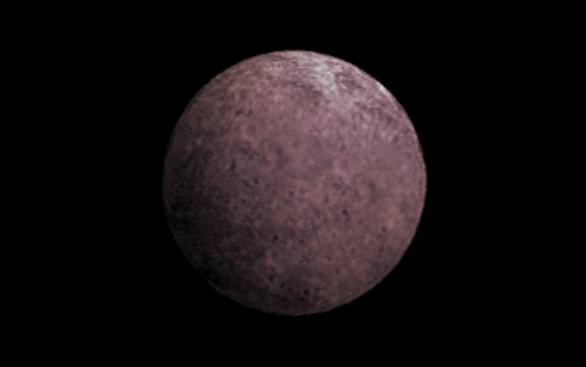Discovered in 2007 by former graduate student Meg Schwamb, dwarf planet Snow White orbits at the edge of the Solar System. Roughly half the size of Pluto, its color was nicknamed erroneously. At one time it was surmised the diminutive planet was a white, icy world broken away from a larger planet, but further studies show it may be the most red of all.
Astronomers at the California Institute of Technology (Caltech) have been taking a much closer look at dwarf planet 2007 OR10. This Kuiper Belt Object is a frozen world, covered in water ice which may have originated volcanically. While the slush covered rock could be assumed to be white, a more rosy hue is in order. Why? According to the new research, Snow White may have a thin atmosphere of methane that’s methodically dissipating.
“You get to see this nice picture of what once was an active little world with water volcanoes and an atmosphere, and it’s now just frozen, dead, with an atmosphere that’s slowly slipping away,” says Mike Brown, the Richard and Barbara Rosenberg Professor and professor of planetary astronomy, who is the lead author on a paper to be published in the Astrophysical Journal Letters describing the findings. “With all of the dwarf planets that are this big, there’s something interesting about them—they always tell us something,” Brown says. “This one frustrated us for years because we didn’t know what it was telling us.”
When dwarf planet 2007 OR10 was first discovered, the best instrument at the time for study was the Near Infrared Camera (NIRC) at the Keck Observatory. But, it wouldn’t be long until Adam Burgasser, a former graduate student of Brown’s and now a professor at UC San Diego, helped design a new instrument called the Folded-port Infrared Echellette (FIRE) to study Kuiper Belt Objects. Last fall, Brown, Burgasser, and postdoctoral scholar Wesley Fraser put FIRE to the test with the 6.5-meter Magellan Baade Telescope in Chile to take a closer look at Snow White. As they had surmised, the little planet was red – but what they weren’t expecting was the presence of water ice. “That was a big shock,” Brown says. “Water ice is not red.”
Is Snow White alone in its rose garden? The answer is no. A few years earlier Brown also discovered another dwarf planet – Quaoar – which had both a red spectrum and water ice. Because of its small size, Quaoar couldn’t hold on to an atmosphere. Over its evolutionary period, the volatile compounds were lost to space, leaving only methane which appears red. Because the spectrum of both small planets are similar, the conclusion is they both share similar properties. “That combination—red and water—says to me, ‘methane,'” Brown explains. “We’re basically looking at the last gasp of Snow White. For four and a half billion years, Snow White has been sitting out there, slowly losing its atmosphere, and now there’s just a little bit left.”
But the team is being cautious for now. While findings point to water ice, the presence of methane isn’t yet documented and will need further studies with larger telescopes like Keck. If their hypothesis turns out to be true, Snow White will join Quaoar as one of two dwarfs capable of keeping their volatile natures intact. Next up for the team is renaming 2007 OR10 since “white” no longer describes it. Before the discovery of water ice and the possibility of methane, “2007 OR10” might have sufficed for the astronomy community, since it didn’t seem noteworthy enough to warrant an official name. “We didn’t know Snow White was interesting,” Brown says. “Now we know it’s worth studying.”
Original Story Source: Caltech News Release. For further reading: Mike Brown’s Planets.


Just a thought. If Kepler looks continuously at one patch of the sky for 3 years would it obtain a 3 year exposer time photo of that region? 🙂 I imagine that that would be the deepest sky photo ever obtained so far.
Could this be a target for New Horizons after it zips past Pluto?
The planets aren’t nicely lined up. Is this object currently at all in the direction of Pluto?
there is nothing noteworthy discovered so far for New Horizons after Pluto.
our solar system is still puzzle .
Martians may have moved there.